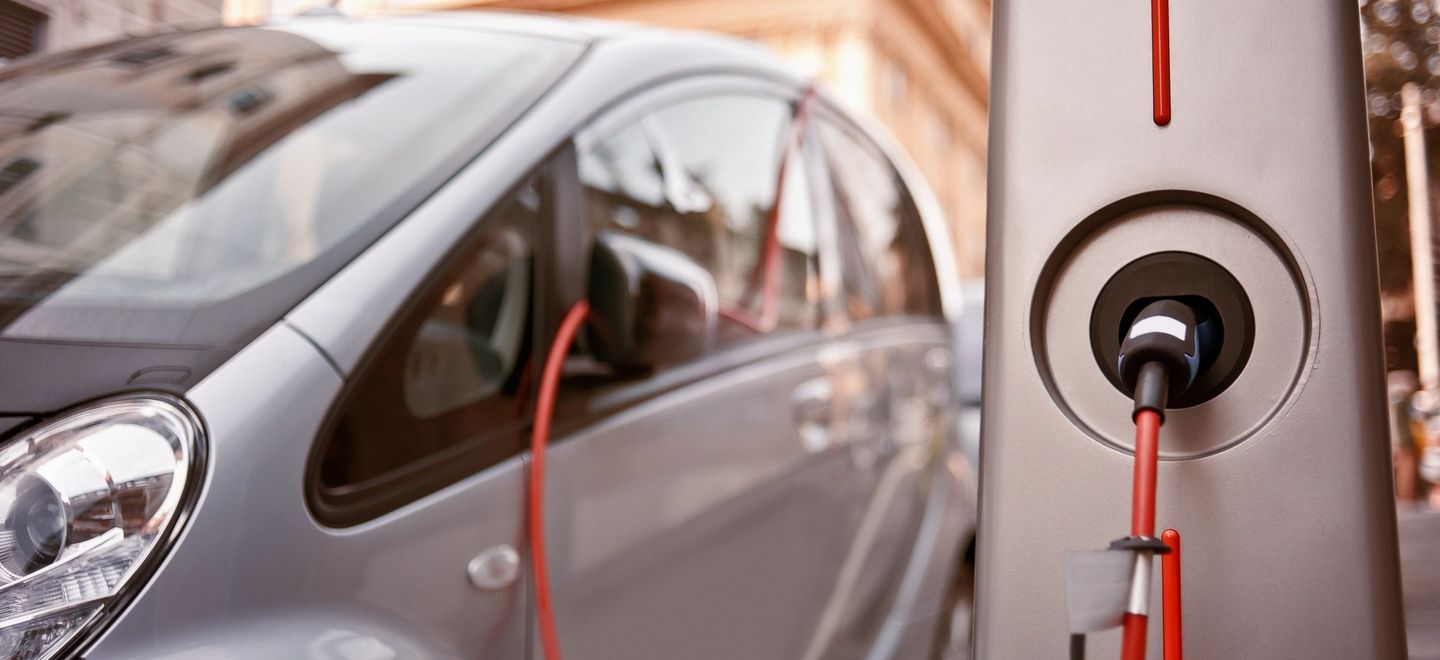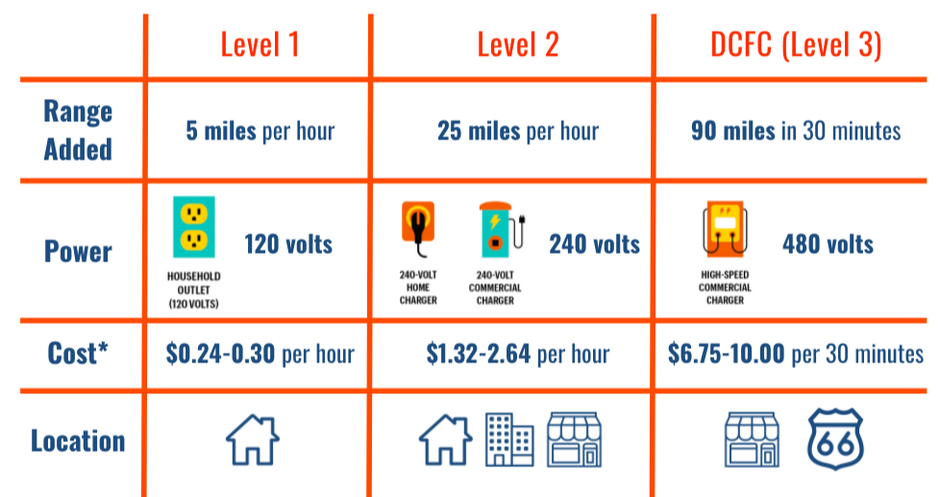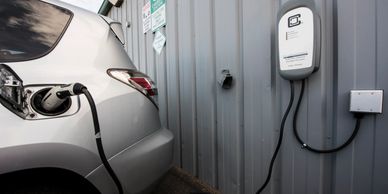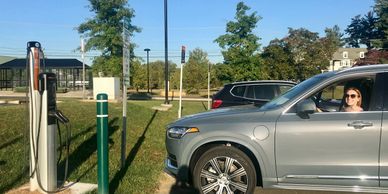Electric Vehicle Charging 101
|
Electric vehicle supply equipment (EVSE) can be installed at home, at work, or in public parking areas.
There are currently hundreds of EVSE providers and whether at a home garage or workplace, there are ways to save on the cost of installation in New York State. Read on for information about:
|
Types of EVSE
There are three types of electric vehicle supply equipment (EVSE): AC Level 1, AC Level 2, and Direct Current Fast Charge (DCFC). Level 1 charging provides the slowest charge time, while DCFC provides the speediest. Level 2 charging is the most available in public parking garages and parking lots, and can be easily installed at home.
Click below for more information about each type of EVSE:
AC Level 1
Most EV drivers charge their vehicles overnight at home using AC Level 1 or AC Level 2 charging equipment, also referred to as Level 1 and Level 2. Only a standard electrical wall outlet and charging cable are required to charge. Charging cables come with your EV.
Level 1 charging generally refers to the use of a standard household outlet, which provides 2.5 to 5 electric miles an hour. Charging your vehicle with a Level 1 charger can take between 8 to 12 hours for a full charge, depending on the size of your battery. Some vehicles with larger batteries can take over a day to fully charge.
Level 1 equipment provides charging through a 120 volt (V), alternating-current (AC) plug and requires a dedicated circuit.
The most common place for Level 1 charging is at a home garage and is typically used overnight. Utilizing Level 1 charging in your home does not require EVSE installation. Level 1 charging equipment is standard on vehicles and therefore is portable. On one end of the provided cord is a standard, three-prong household plug. On the other end is a connector, which plugs into the vehicle.
Level 1 charging generally refers to the use of a standard household outlet, which provides 2.5 to 5 electric miles an hour. Charging your vehicle with a Level 1 charger can take between 8 to 12 hours for a full charge, depending on the size of your battery. Some vehicles with larger batteries can take over a day to fully charge.
Level 1 equipment provides charging through a 120 volt (V), alternating-current (AC) plug and requires a dedicated circuit.
The most common place for Level 1 charging is at a home garage and is typically used overnight. Utilizing Level 1 charging in your home does not require EVSE installation. Level 1 charging equipment is standard on vehicles and therefore is portable. On one end of the provided cord is a standard, three-prong household plug. On the other end is a connector, which plugs into the vehicle.
AC Level 2
Typically, Level 2 charging is used at home, workplaces, and in public parking areas.
Level 2 equipment offers charging through a 240V, AC plug and requires installation of home charging or public charging equipment.
The units provide 10-25 electric miles an hour and typically take 4 to 6 hours to charge a fully depleted battery, with some vehicles taking longer than 6 hours to fully charge.
Level 2 charging equipment is compatible with all electric vehicles and plug-in electric hybrid vehicles. Level 2 chargers have a cord that plugs directly into the vehicle in the same connector location used for Level 1 equipment.
Level 2 chargers are found in residential complexes, public parking areas, workplaces and business, and commercial settings. In New York City, charging can even be found at curbside locations through a NYC Department of Transportation pilot.
To find a Level 2 charger near you, check out our station locator.
Level 2 equipment offers charging through a 240V, AC plug and requires installation of home charging or public charging equipment.
The units provide 10-25 electric miles an hour and typically take 4 to 6 hours to charge a fully depleted battery, with some vehicles taking longer than 6 hours to fully charge.
Level 2 charging equipment is compatible with all electric vehicles and plug-in electric hybrid vehicles. Level 2 chargers have a cord that plugs directly into the vehicle in the same connector location used for Level 1 equipment.
Level 2 chargers are found in residential complexes, public parking areas, workplaces and business, and commercial settings. In New York City, charging can even be found at curbside locations through a NYC Department of Transportation pilot.
To find a Level 2 charger near you, check out our station locator.
Direct Current Fast Charging (DCFC)
DCFC (Direct Current Fast Chargers) are the fastest chargers for EVs. These are sometimes referred to as Level 3 chargers. DCFC charges up to 80% of a vehicle’s battery in 20 minutes, or between 60 and 100 miles of range. A good average is 90 miles in 30 minutes.
DCFC are most often found in public charging stations, especially along heavy traffic corridors or near retail and shopping areas.
DC Fast Charging provides charging through 480 Volt AC input and requires specialized, high-powered charging equipment and special equipment in the vehicle itself. While Level 1 and Level 2 charging is standardized, multiple charging plugs exist for DC Fast Charging depending on the vehicle manufacturer.
The three plug types are: CHAdeMO (used by most Japanese and Korean plug-in cars); CCS Combo (used by most American and European plug-in cars); and Tesla Superchargers.
To find a DC Fast Charge or Level 2 charger, go to the station locator.
DCFC are most often found in public charging stations, especially along heavy traffic corridors or near retail and shopping areas.
DC Fast Charging provides charging through 480 Volt AC input and requires specialized, high-powered charging equipment and special equipment in the vehicle itself. While Level 1 and Level 2 charging is standardized, multiple charging plugs exist for DC Fast Charging depending on the vehicle manufacturer.
The three plug types are: CHAdeMO (used by most Japanese and Korean plug-in cars); CCS Combo (used by most American and European plug-in cars); and Tesla Superchargers.
To find a DC Fast Charge or Level 2 charger, go to the station locator.
Note: Range, charging times, and costs may vary based on type of vehicle and charging location.
*Cost assumptions: L1: $0.20-0.25 per kWh and 1.2 kW max charger capacity; L2: $0.20-0.40 per kWh and 6.6 kW max charger capacity;
DCFC (L3): $0.27-0.40 per kWh and 50 kW max charger capacity.
** 'Power' icons borrowed from AARP Auto, "Electric Cars: Chevy Bolt EV vs. Tesla Model 3." December 5, 2018.
*Cost assumptions: L1: $0.20-0.25 per kWh and 1.2 kW max charger capacity; L2: $0.20-0.40 per kWh and 6.6 kW max charger capacity;
DCFC (L3): $0.27-0.40 per kWh and 50 kW max charger capacity.
** 'Power' icons borrowed from AARP Auto, "Electric Cars: Chevy Bolt EV vs. Tesla Model 3." December 5, 2018.
Where to charge?
Just as an internal combustion engine (ICE) vehicle won’t run without gas in the tank, an electric vehicle won’t run unless its battery is sufficiently charged. While ICE drivers fill-up at a gas station, EV owners have multiple options for replenishing their rides.
|
Charge at Home
Most EV drivers charge their vehicles overnight at home using AC Level 1 or AC Level 2 charging equipment. Level 1 means plugging in directly to a standard electrical wall outlet! Level 2 equipment can be easily and affordably installed in home garages.
|
Charge at Work
Workplace charging helps commuters who drive an EV destination charge at work, where cars are left parked for long periods of time. Programs like Charge Ready NY provide financial incentives for employers to install EVSE, as well as additional savings for employees to purchase new EVs.
|
Charge On-the-go
Did you know there are approximately 3,000 charging units in New York and over 20,000 in the US? Many of these are open to the public, and can be found in public garages, parking lots, and even at the street curb. Plugshare.com is a free resource that provides the locations of these stations.
|
Savings Opportunities
Whether you are looking to install EVSE in your home, workplace, or commercial business, there is a savings opportunity for you!
- Charge Ready NY 2.0
Charge Ready NY offers public and private organizations that install Level 2 EV charging stations at public parking facilities, workplaces, and multifamily apartment buildings rebates of $4,000 per charging port. - New York State Alternative Fuels & EV Recharging Property Credit
You or your business is entitled to a nonrefundable credit for investments in new electric vehicle recharging property. - Federal Alternative Fuel Vehicle Refueling Property Credit
The Alternative Fuel Vehicle (AFV) Refueling Property Credit from the IRS gives eligible US businesses and residents 30% off their entire EV charging hardware purchase (up to $30,000).







